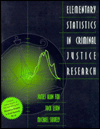

 |

|

Sold Out
Book Categories |
All chapters conclude with "Summary," "Terms to Remember," and "Questions and Problems."
Preface.
1. Why the Criminal Justice Researcher Uses Statistics.
The Nature of Criminal Justice Research.
Major Data Sources in Criminology and Criminal Justice.
Why Test Hypotheses?
The Stages of Criminal Justice Research.
Using Series of Numbers to Do Criminal Justice Research.
Functions of Statistics.
Looking and the Larger Picture: A Student Survey.
I. DESCRIPTION.
2. Organizing the Data.
Frequency Distributions of Nominal Data.
Comparing Distributions.
Proportions and Percentages.
Ratios and Rates.
Simple Frequency Distributions of Ordinal and Interval Data.
Grouped Frequency Distributions of Interval Data.
Cumulative Distributions.
Percentile Ranks.
Dealing with Decimal Data.
Flexible Class Intervals.
Cross-Tabulations.
Graphic Presentations.
3. Measures of Central Tendency.
The Mode.
The Median.
The Mean.
Taking One Step at a Time.
Comparing the Mode, Median, and Mean.
Obtaining the Mode, Median, and Mean from a Simple Frequency Distribution.
Obtaining the Mode, Median, and Mean from a Grouped Frequency Distribution.
Step-By-Step Study Guide: Mode, Median, and Mean for Raw Scores.
4. Measures of Variability.
The Range.
The Mean Deviation.
The Variance and Standard Deviation.
The Raw-Score Formula for Variance and Standard Deviation.
The Meaning of the Standard Deviation.
Comparing Measures ofVariability.
Obtaining the Variance and Standard Deviation from a Simple Frequency Distribution.
Obtaining the Variance and Standard Deviation from a Grouped Frequency Distribution.
Step-By-Step Study Guide: Variance and Standard Deviation for Raw Scores.
II. FROM DESCRIPTION TO DECISION MAKING.
5. Probability and the Normal Curve.
Rules of Probability.
Probability Distributions.
The Normal Curve as a Probability Distribution.
Characteristics of the Normal Curve.
The Model and the Reality of the Normal Curve.
The Area Under the Normal Curve.
Standard Scores and the Normal Curve.
Finding Probability Under the Normal Curve.
Obtaining Percentile Ranks from the Normal Curve.
Step-By-Step Study Guide: Probability Under the Normal Curve.
Step-By-Step Study Guide: Percentile Ranks from the Normal Curve.
6. Samples and Populations.
Sampling Methods.
Sampling Error.
Sampling Distribution of Means.
Standard Error of the Mean.
Confidence Intervals.
The t Distribution.
Estimating Proportions.
Step-By-Step Study Guide: Confidence Interval for the Mean Using z
Step-By-Step Study Guide: Confidence Interval for the Mean Using t
Step-By-Step Study Guide: Confidence Interval for the Proportion.
Looking at the Larger Picture: Generalizing from Samples to Populations.
III. DECISION MAKING.
7. Testing Differences between Means.
The Null Hypothesis: No Difference between Means.
The Research Hypothesis: A Difference between Means.
Sampling Distribution of Differences between Means.
Testing Hypotheses with the Distribution of Differences between Means.
Levels of Significance.
Standard Error of the Difference between Means.
Testing the Difference between Means.
Comparing the Same Sample Measured Twice.
Two Sample Tests of Proportions.
One-Tailed Tests.
Requirements for Testing the Difference between Means.
Step-By-Step Study Guide: Test of Differences between Means for Independent Groups.
Step-By-Step Study Guide: Test of Differences between Means for the Same Sample Measured Twice.
Step-By-Step Study Guide: Test of Differences between Proportions.
8. Analysis of Variance.
The Logic of Analysis of Variance.
The Sum of Squares.
Mean Square.
The F Ratio.
A Multiple Comparison of Means.
Requirements for Using the F Ratio.
Step-By-Step Study Guide: Test of Differences between Means for Several Independent Groups Using Analysis of Variance.
9. Nonparametric Tests of Significance.
One-Way Chi-Square Test.
Two-Way Chi-Square Test.
The Median Test.
The Mann-Whitney U Test.
Kruskal-Wallis One-Way Analysis of Variance by Ranks.
Step-By-Step Study Guide: Test of Differences between Groups for Nominal-Level Data Using Chi-Square.
Step-By-Step Study Guide: Test of Differences between Groups for Ordinal-Level Data Using the Mann-Whitney U Test.
Step-By-Step Study Guide: Test of Differences between Several Groups for Ordinal-Level Data Using the Kruskal-Wallis Test.
Looking at the Larger Picture: Testing for Differences.
IV. FROM DECISION MAKING TO ASSOCIATION.
10. Correlation.
Strength of Correlation.
Direction of Correlation.
Curvilinear Correlation.
The Correlation Coefficient.
Pearson's Correlation Coefficient.
The Importance of Scatter Plots.
Partial Correlation.
Step-By-Step Study Guide: Testing the Strength of Association between Interval-Level Variables Using Pearson's Correlation.
11. Regression Analysis.
The Regression Model.
Interpreting the Regression Line.
Prediction Errors.
Regression and Pearson's Correlation.
Regression and Analysis of Variance.
Multiple Regression.
Step-By-Step Study Guide: Testing the Effect of an Independent Variable on a Dependent Variable Using Regression Analysis.
12. Nonparametric Measures of Correlation.
Spearman's Rank-Order Correlation Coefficient.
Goodman's and Kruskal's Gamma.
Correlation Coefficient for Nominal Data Arranged in a 2 x 2 Table.
Correlation Coefficients for Nominal Data in Larger than 2 x 2 Tables.
Lambda.
Elaboration.
Step-By-Step Study Guide: Testing the Strength of Association between Ordinal-Level Variables Using Spearman's Rank-Order Correlation.
Step-By-Step Study Guide: Testing the Strength of Association between Cross-Table Ordinal-Level Variables Using Goodman's and Kruskal's Gamma
Looking at the Larger Picture: Measuring Associations.
13. Applying Statistical Procedures to Research Problems.
Research Situations.
Research Solutions.
Appendix A: Crime and Criminal Justice Internet Sites.
Appendix B: A Review of Some Fundamentals of Mathematics.
Appendix C: Tables.
Appendix D: List of Formulas.
Glossary.
Answers to Problems.
Index.
Supplements
Instructor Supplements
Student Supplements
Course Codes
Login|Complaints|Blog|Games|Digital Media|Souls|Obituary|Contact Us|FAQ
CAN'T FIND WHAT YOU'RE LOOKING FOR? CLICK HERE!!! X
 You must be logged in to add to WishlistX
 This item is in your Wish ListX
 This item is in your CollectionElementary Statistics in Criminal Justice Research
X
 This Item is in Your InventoryElementary Statistics in Criminal Justice Research
X
 You must be logged in to review the productsX
 X
 X

Add Elementary Statistics in Criminal Justice Research, The best-selling book, Elementary Statistics in Social Research, 7/e, has been adapted to provide a broad and accessible introduction to statistics for criminal justice enthusiasts. This straightforward book written specifically for criminal justice helps, Elementary Statistics in Criminal Justice Research to the inventory that you are selling on WonderClubX
 X

Add Elementary Statistics in Criminal Justice Research, The best-selling book, Elementary Statistics in Social Research, 7/e, has been adapted to provide a broad and accessible introduction to statistics for criminal justice enthusiasts. This straightforward book written specifically for criminal justice helps, Elementary Statistics in Criminal Justice Research to your collection on WonderClub |